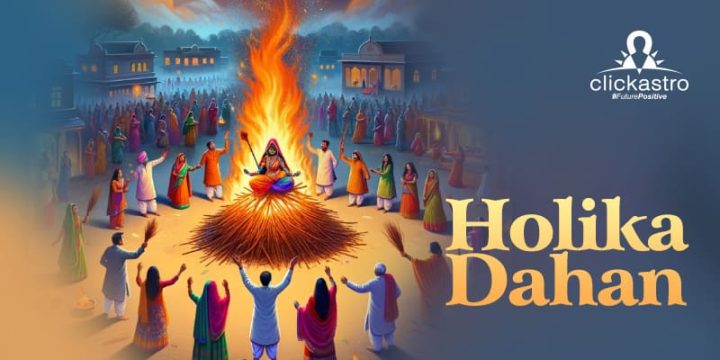Holika Dahan
Holika Dahan is seen as the prelude to the iconic
festival of Holi. It resonates deeply within Hindu culture and embodies rich traditions and symbolic narratives. This sacred ritual, observed on the eve of Holi, serves as a powerful metaphor for the triumph of virtue over malevolence. Anchored in the ancient legend of
Prahlad, Hiranyakashipu, and Holika, the ceremonial bonfire encapsulates a timeless tale of resilience and divine intervention.
Beyond its religious connotations, Holika Dahan is also a depiction of communal unity and jubilation. As families and communities gather around the flickering flames, the spirit of togetherness blossoms, fostering a shared sense of joy. This ritual, illuminated by the warmth of camaraderie, not only honors cultural heritage but also encapsulates the essence of Holi – a festival that transcends religious boundaries, radiating the colors of harmony and fellowship.
Holika Dahan Date and Timing
Holika Dahan will be observed on Sunday, March 24.
The auspicious Holika Dahan Muhurta falls between 06:35 PM – 08:58 PM, spanning 02 hours 23 mins. Adherence to specific timing guidelines, especially during the Pradosh Kaal and avoiding the Bhadra period, is emphasized for prosperity and auspicious beginnings.
2024 Holika Dahan Muhurat, Tithi & Bhadra Timing
- Sunrise – March 24, 06:30 AM.
- Sunset – March 24, 06:35 PM.
- Purnima Tithi Timing – March 24, 09:55 AM – March 25, 12:30 PM
- Holika Dahan Muhurta – March 24, 06:35 PM – 08:58 PM
- Bhadra Punchha Time – March 24, 06:33 PM – 07:53 PM
- Bhadra Mukha Time – March 24, 07:53 PM – 10:06 PM
Holika Dahan Story: Prahlad, Hiranyakashipu, and Holika
Holika Dahan draws its legacy from the ancient saga of
Hiranyakashipu, the mighty demon monarch who was endowed with the boon of invincibility by Lord Brahma. His dominion was marked by tyranny, and he detested his son, Prahlad, for Prince Prahlad was a staunch devotee of Lord Vishnu. Growing desperate with time, Hiranyakashipu finally decided to eradicate Prahlad’s unwavering faith once and for all. He sought the aid of his sister Holika, who was granted immunity to fire, to carry out the task.
The cunning plan unfolded as Holika, with Prahlad in her lap, entered a blazing pyre. The notion was that the fiery flames of the pyre would burn Prahlad while Holika, immune to fire, would survive. However, divine intervention followed, and to everyone’s astonishment, Prahlad emerged unscathed, while Holika succumbed to the flames. This pivotal moment exemplified the indomitable spirit of righteousness prevailing over malevolence, echoing the overarching theme of good triumphing over evil.
Holika Dahan, observed on the eve of Holi, reverently commemorates this celestial intervention. The ceremonial bonfire symbolizes the cleansing flames of virtue, purging the malevolent forces from our lives. Prahlad’s unwavering devotion and the subsequent divine intervention serve as a timeless allegory, fostering not only a religious celebration but also a cultural affirmation of the enduring victory of righteousness.
Rituals and Preparation
In the days leading up to Holika Dahan, a flurry of activity unfolds as communities embark on preparations for this sacred occasion. The gathering of wood and combustible materials becomes a communal effort, symbolizing the collective spirit that characterizes the festival. As the eve approaches, the air is infused with anticipation, and Holika Puja takes center stage. This ritual is conducted on an auspicious evening, either within homes or at the designated Holika Dahan site.
Symbolic effigies of Prahlad and Holika are carefully arranged atop a mound of wood, setting the stage for the ceremonial bonfire. The burning flames serve as a potent metaphor for the purification of hearts and the triumph of good over evil. Devotees partake in Holika Puja, chanting Rakshoghna Mantras, invoking divine protection to dispel negative energies and fortify the sanctity of the ritual.
In certain regions, a distinctive tradition involves roasting “jau” in the sacred fire. This roasted grain is then taken home, symbolizing a harbinger of good luck and prosperity. The atmosphere is charged with festivity as devotees engage in joyous dancing, singing, and “Parikrama” or circumambulation around the blazing bonfire. This collective celebration not only reinforces the religious significance of Holika Dahan but also fosters a sense of communal joy and togetherness.
Thandi Holi Ritual
In specific regions of Northern India, the cultural landscape of Holi is enriched with the traditional observance of “Thandi Holi.” This unique ritual unfolds in the afternoon preceding Holika Dahan and is predominantly observed by married women. Central to Thandi Holi is a fasting practice that endures until the evening puja. Women abstain from consuming food throughout the day, demonstrating their devotion and commitment.
As the sun sets, families gather for the puja, seeking blessings for the well-being of their loved ones. Offerings are tendered to Holika, emblematic of gratitude and supplication. The culmination of the fast is marked by a shared, sumptuous meal with family members, breaking the day-long restraint. Thandi Holi not only honors tradition but also serves as a poignant expression of familial bonds, as women come together to seek blessings and share in the joyous breaking of the fast.
Holi Day: Collecting Sacred Ash
On the vibrant day of Holi, a ritual of profound significance unfolds as people gather the residual ash from the ceremonial bonfire. This sacred ash, revered as “Holi Prasad,” holds symbolic potency in the post-celebratory customs. Devotees apply this ash on their foreheads or limbs, engaging in an act of purification that transcends the physical realm.
The application of Holi Prasad is more than a mere ritual; it encapsulates the enduring theme of good triumphing over evil, as manifested in the sacred flames of Holika Dahan. As the ash adorns the skin, it symbolizes the continuation of righteousness and invites blessings for a life adorned with prosperity and virtue. This practice not only deepens the spiritual connection with the festival but also serves as a tangible reminder of the triumph of goodness in the ongoing journey of life.
Conclusion
In conclusion, Holika Dahan stands as a luminous event woven with tradition and symbolism, transcending religious confines to embrace a shared celebration of unity and joy. Rooted in the timeless saga of Prahlad, the ritual encapsulates the enduring message of conquering adversity with unwavering virtue. As families converge to participate in these sacred rites, Holika Dahan transforms into a radiant beacon of hope.
This celebration not only reaffirms cultural ties but also becomes a collective affirmation of happiness, prosperity, and the perpetual victory of good over evil. In the dance of flames and the shared echoes of devotion, Holika Dahan unites hearts in a harmonious celebration, leaving an indelible mark on the canvas of shared traditions and fostering a sense of communal strength in the face of life’s challenges.








